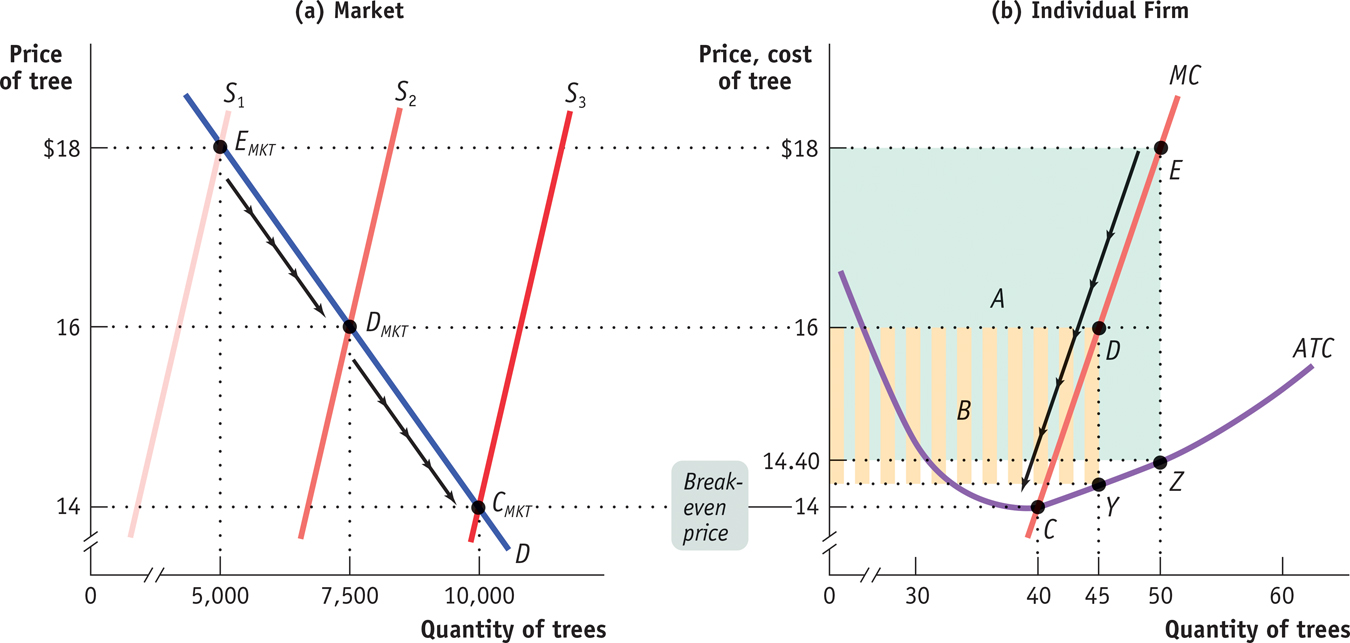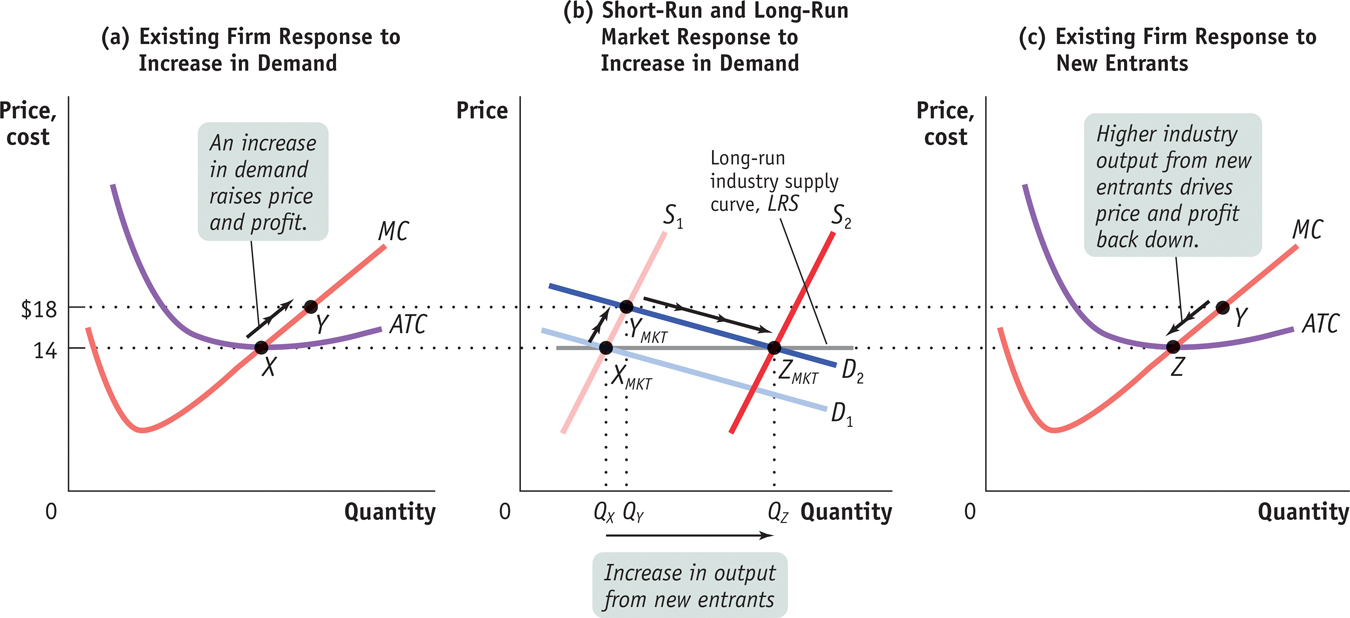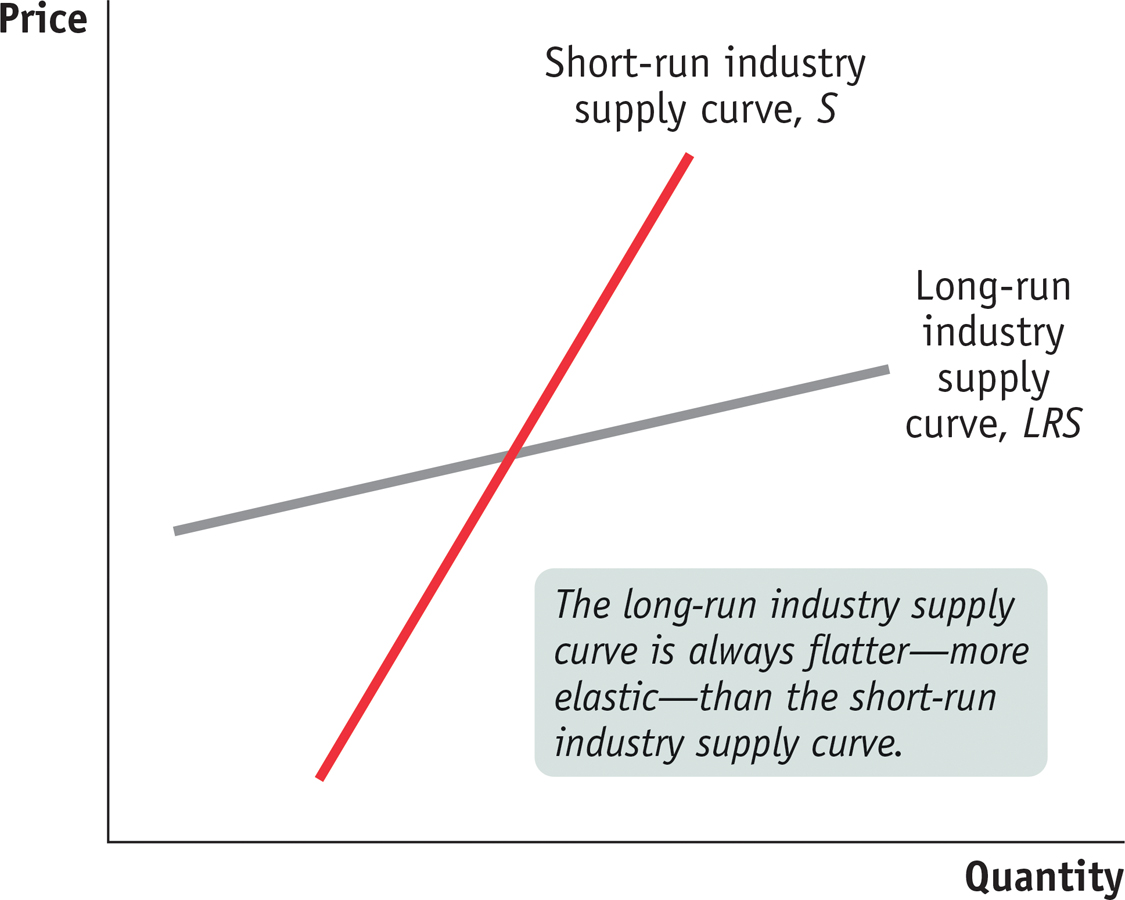The Long-Run Industry Supply Curve
Suppose that in addition to the 100 farms currently in the Christmas tree business, there are many other potential producers. Suppose also that each of these potential producers would have the same cost curves as existing producers like Noelle if it entered the industry.
When will additional producers enter the industry? Whenever existing producers are making a profit—that is, whenever the market price is above the break-even price of $14 per tree, the minimum average total cost of production. For example, at a price of $18 per tree, new firms will enter the industry.
What will happen as additional producers enter the industry? Clearly, the quantity supplied at any given price will increase. The short-run industry supply curve will shift to the right. This will, in turn, alter the market equilibrium and result in a lower market price. Existing firms will respond to the lower market price by reducing their output, but the total industry output will increase because of the larger number of firms in the industry.
Figure 12-6 illustrates the effects of this chain of events on an existing firm and on the market; panel (a) shows how the market responds to entry, and panel (b) shows how an individual existing firm responds to entry. (Note that these two graphs have been rescaled in comparison to Figures 12-4 and 12-5 to better illustrate how profit changes in response to price.) In panel (a), S1 is the initial short-run industry supply curve, based on the existence of 100 producers. The initial short-run market equilibrium is at EMKT, with an equilibrium market price of $18 and a quantity of 5,000 trees. At this price existing producers are profitable, which is reflected in panel (b): an existing firm makes a total profit represented by the green-shaded rectangle labeled A when market price is $18.

The Long-Run Market Equilibrium Point EMKT of panel (a) shows the initial short-run market equilibrium. Each of the 100 existing producers makes an economic profit, illustrated in panel (b) by the green rectangle labeled A, the profit of an existing firm. Profits induce entry by additional producers, shifting the short-run industry supply curve outward from S1 to S2 in panel (a), resulting in a new short-run equilibrium at point DMKT, at a lower market price of $16 and higher industry output. Existing firms reduce output and profit falls to the area given by the striped rectangle labeled B in panel (b). Entry continues to shift out the short-run industry supply curve, as price falls and industry output increases yet again. Entry of new firms ceases at point CMKT on supply curve S3 in panel (a). Here market price is equal to the break-even price; existing producers make zero economic profits, and there is no incentive for entry or exit. So CMKT is also a long-run market equilibrium.
These profits will induce new producers to enter the industry, shifting the short-run industry supply curve to the right. For example, the short-run industry supply curve when the number of producers has increased to 167 is S2. Corresponding to this supply curve is a new short-run market equilibrium labeled DMKT, with a market price of $16 and a quantity of 7,500 trees. At $16, each firm produces 45 trees, so that industry output is 167 × 45 = 7,500 trees (rounded).
From panel (b) you can see the effect of the entry of 67 new producers on an existing firm: the fall in price causes it to reduce its output, and its profit falls to the area represented by the striped rectangle labeled B.
Although diminished, the profit of existing firms at DMKT means that entry will continue and the number of firms will continue to rise. If the number of producers rises to 250, the short-run industry supply curve shifts out again to S3, and the market equilibrium is at CMKT, with a quantity supplied and demanded of 10,000 trees and a market price of $14 per tree.
A market is in long-run market equilibrium when the quantity supplied equals the quantity demanded, given that sufficient time has elapsed for entry into and exit from the industry to occur.
Like EMKT and DMKT, CMKT is a short-run equilibrium. But it is also something more. Because the price of $14 is each firm’s break-even price, an existing producer makes zero economic profit—neither a profit nor a loss, earning only the opportunity cost of the resources used in production—when producing its profit-maximizing output of 40 trees. At this price there is no incentive either for potential producers to enter or for existing producers to exit the industry. So CMKT corresponds to a long-run market equilibrium—a situation in which the quantity supplied equals the quantity demanded given that sufficient time has elapsed for producers to either enter or exit the industry. In a long-run market equilibrium, all existing and potential producers have fully adjusted to their optimal long-run choices; as a result, no producer has an incentive to either enter or exit the industry.
To explore further the significance of the difference between short-run and long-run equilibrium, consider the effect of an increase in demand on an industry with free entry that is initially in long-run equilibrium. Panel (b) in Figure 12-7 shows the market adjustment; panels (a) and (c) show how an existing individual firm behaves during the process.

The Effect of an Increase in Demand in the Short Run and the Long Run Panel (b) shows how an industry adjusts in the short and long run to an increase in demand; panels (a) and (c) show the corresponding adjustments by an existing firm. Initially the market is at point XMKT in panel (b), a short-run and long-run equilibrium at a price of $14 and industry output of QX. An existing firm makes zero economic profit, operating at point X in panel (a) at minimum average total cost. Demand increases as D1 shifts rightward to D2 in panel (b), raising the market price to $18. Existing firms increase their output, and industry output moves along the short-run industry supply curve S1 to a short-run equilibrium at YMKT. Correspondingly, the existing firm in panel (a) moves from point X to point Y. But at a price of $18 existing firms are profitable. As shown in panel (b), in the long run new entrants arrive and the short-run industry supply curve shifts rightward, from S1 to S2. There is a new equilibrium at point ZMKT, at a lower price of $14 and higher industry output of QZ. An existing firm responds by moving from Y to Z in panel (c), returning to its initial output level and zero economic profit. Production by new entrants accounts for the total increase in industry output, QZ − Qx. Like XMKT, ZMKT is also a short-run and long-run equilibrium: with existing firms earning zero economic profit, there is no incentive for any firms to enter or exit the industry. The horizontal line passing through XMKT and ZMKT, LRS, is the long-run industry supply curve: at the break-even price of $14, producers will produce any amount that consumers demand in the long run.
In panel (b) of Figure 12-7, D1 is the initial demand curve and S1 is the initial short-run industry supply curve. Their intersection at point XMKT is both a short-run and a long-run market equilibrium because the equilibrium price of $14 leads to zero economic profit—and therefore neither entry nor exit. It corresponds to point X in panel (a), where an individual existing firm is operating at the minimum of its average total cost curve.
Now suppose that the demand curve shifts out for some reason to D2. As shown in panel (b), in the short run, industry output moves along the short-run industry supply curve S1 to the new short-run market equilibrium at YMKT, the intersection of S1 and D2. The market price rises to $18 per tree, and industry output increases from QX to QY. This corresponds to an existing firm’s movement from X to Y in panel (a) as the firm increases its output in response to the rise in the market price.
But we know that YMKT is not a long-run equilibrium, because $18 is higher than minimum average total cost, so existing producers are making economic profits. This will lead additional firms to enter the industry.
Over time entry will cause the short-run industry supply curve to shift to the right. In the long run, the short-run industry supply curve will have shifted out to S2, and the equilibrium will be at ZMKT—with the price falling back to $14 per tree and industry output increasing yet again, from QY to QZ. Like XMKT before the increase in demand, ZMKT is both a short-run and a long-run market equilibrium.
The effect of entry on an existing firm is illustrated in panel (c), in the movement from Y to Z along the firm’s individual supply curve. The firm reduces its output in response to the fall in the market price, ultimately arriving back at its original output quantity, corresponding to the minimum of its average total cost curve. In fact, every firm that is now in the industry—the initial set of firms and the new entrants—will operate at the minimum of its average total cost curve, at point Z. This means that the entire increase in industry output, from QX to QZ, comes from production by new entrants.
The long-run industry supply curve shows how the quantity supplied responds to the price once producers have had time to enter or exit the industry.
The line LRS that passes through XMKT and ZMKT in panel (b) is the long-run industry supply curve. It shows how the quantity supplied by an industry responds to the price given that producers have had time to enter or exit the industry.
In this particular case, the long-run industry supply curve is horizontal at $14. In other words, in this industry supply is perfectly elastic in the long run: given time to enter or exit, producers will supply any quantity that consumers demand at a price of $14. Perfectly elastic long-run supply is actually a good assumption for many industries. In this case we speak of there being constant costs across the industry: each firm, regardless of whether it is an incumbent or a new entrant, faces the same cost structure (that is, they each have the same cost curves). Industries that satisfy this condition are industries in which there is a perfectly elastic supply of inputs—industries like agriculture or bakeries.
In other industries, however, even the long-run industry supply curve slopes upward. The usual reason for this is that producers must use some input that is in limited supply (that is, inelastically supplied). As the industry expands, the price of that input is driven up. Consequently, later entrants in the industry find that they have a higher cost structure than early entrants. An example is beachfront resort hotels, which must compete for a limited quantity of prime beachfront property. Industries that behave like this are said to have increasing costs across the industry.
It is possible for the long-run industry supply curve to slope downward. This can occur when an industry faces increasing returns to scale, in which average costs fall as output rises. Notice we said that the industry faces increasing returns. However, when increasing returns apply at the level of the individual firm, the industry usually ends up dominated by a small number of firms (an oligopoly) or a single firm (a monopoly).
In some cases, the advantages of large scale for an entire industry accrue to all firms in that industry. For example, the costs of new technologies such as solar panels tend to fall as the industry grows because that growth leads to improved knowledge, a larger pool of workers with the right skills, and so on.
Regardless of whether the long-run industry supply curve is horizontal or upward sloping or even downward sloping, the long-run price elasticity of supply is higher than the short-run price elasticity whenever there is free entry and exit. As shown in Figure 12-8, the long-run industry supply curve is always flatter than the short-run industry supply curve. The reason is entry and exit: a high price caused by an increase in demand attracts entry by new producers, resulting in a rise in industry output and an eventual fall in price; a low price caused by a decrease in demand induces existing firms to exit, leading to a fall in industry output and an eventual increase in price.

Comparing the Short-Run and Long-Run Industry Supply Curves The long-run industry supply curve may slope upward, but it is always flatter—more elastic—than the short-run industry supply curve. This is because of entry and exit: a higher price attracts new entrants in the long run, resulting in a rise in industry output and a fall in price; a lower price induces existing producers to exit in the long run, generating a fall in industry output and an eventual rise in price.
The distinction between the short-run industry supply curve and the long-run industry supply curve is very important in practice. We often see a sequence of events like that shown in Figure 12-7: an increase in demand initially leads to a large price increase, but prices return to their initial level once new firms have entered the industry. Or we see the sequence in reverse: a fall in demand reduces prices in the short run, but they return to their initial level as producers exit the industry.


